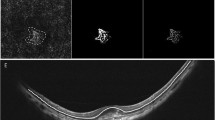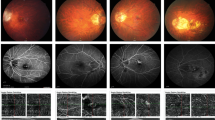Abstract
Purpose
To evaluate functional prognostic factors and neuroretinal changes after anti-vascular endothelial growth factor (VEGF) treatment in patients with naïve, recent myopic neovascularization (mCNV), as assessed by spectral-domain optical coherence tomography (SD-OCT).
Methods
Specific changes in tomographic features between baseline and final follow-up were retrospectively evaluated by two examiners independently. Imaging was obtained by a multi-modal imaging system which combines fluorescein angiography and SD-OCT.
Results
Twenty-two eyes (male, six; female, 16; mean age, 65 ± 14 years) were considered. Mean follow-up was 21.5 ± 14 months. Best-corrected visual acuity (BCVA) improved from 0.38 ± 0.26 to 0.16 ± 0.20 logMAR (p < 0.001). The ellipsoid zone and the external limiting membrane (ELM) were disrupted in 21 (95.5%) and 15 (68.2%) eyes at baseline, and in 16 (72.7%) and nine (40.9%) eyes after therapy respectively. The ellipsoid zone and ELM were typically intact at lesion margins in 13 (59.1%) and 19 eyes (86.5%) respectively at baseline. The inner retina was intact in 20 eyes (91%). Six eyes (27.3%) exhibited complete regression without fibrosis. Absence of hemorrhage and integrity of lesion-adjacent ELM and of lesion-adjacent ellipsoid zone at baseline were factors for better final BCVA (p ≤ 0.05)
Conclusion
Vision gain might occur despite ellipsoid zone or ELM restoration. Hemorrhage could be considered a negative prognostic factor, integrity of lesion-adjacent ELM and of lesion-adjacent ellipsoid zone as positive prognostic factors. Myopic CNV can also resolve completely without fibrosis.


Similar content being viewed by others
References
Freund KB, Zweifel SA, Engelbert M (2010) Do we need a new classification for choroidal neovascularization in age-related macular degeneration? Retina 30:1333–1349
Keane PA, Liakopoulos S, Chang KT, Heussen FM, Ongchin SC, Walsh AC, Sadda SR (2008) Comparison of the optical coherence tomographic features of choroidal neovascular membranes in pathological myopia versus age-related macular degeneration, using quantitative subanalysis. Br J Ophthalmol 92:1081–1085
Wang E, Chen Y (2013) Intravitreal anti-vascular endothelial growth factor for choroidal neovascularization secondary to pathologic myopia: systematic review and meta-analysis. Retina 33:1375–1392
Wong TY, Ferreira A, Hughes R et al (2014) Epidemiology and disease burden of pathologic myopia and myopic choroidal neovascularization: an evidence-based systematic review. Am J Ophthalmol 157:9–25
Freitas-da-Costa P, Pinheiro-Costa J, Carvalho B, Falcão M, Brandão E, Falcão-Reis F, Carneiro  (2014) Anti-VEGF therapy in myopic choroidal neovascularization: long-term results. Ophthalmologica 232:57–63
Ng DS, Kwok AK, Chan CW (2012) Anti-vascular endothelial growth factor for myopic choroidal neovascularization. Clin Experiment Ophthalmol 40:e98–e110
Ikuno Y, Ohno-Matsui K, Wong TY, Korobelnik JF, Vitti R, Li T, Stemper B, Asmus F, Zeitz O, Ishibashi T, MYRROR Investigators (2015) Intravitreal aflibercept injection in patients with myopic choroidal neovascularization: the MYRROR study. Ophthalmology 122:1220–1227
Baba T, Ohno-Matsui K, Yoshida T et al (2002) Optical coherence tomography of choroidal neovascularization in high myopia. Acta Ophthalmol Scand 80:82–87
Milani P, Pece A, Pierro L, Bergamini F (2014) Imaging of naive myopic choroidal neovascularization by spectral-domain optical coherence tomography. Ophthalmologica 232:28–36
Introini U, Casalino G, Querques G, Gimeno AT, Scotti F, Bandello F (2012) Spectral-domain OCT in anti-VEGF treatment of myopic choroidal neovascularization. Eye (Lond) 26:976–982
Bruyère E, Caillaux V, Cohen SY, Martiano D, Ores R, Puche N, Souied EH (2015) Spectral-domain optical coherence tomography of subretinal hyperreflective exudation in myopic choroidal neovascularization. Am J Ophthalmol 160:749–758
Battaglia Parodi M, Iacono P, Bandello F (2016) Correspondence of leakage on fluorescein angiography and optical coherence tomography parameters in diagnosis and monitoring of myopic choroidal neovascularization treated with bevacizumab. Retina 36:104–109
Mathew R, Richardson M, Sivaprasad S (2013) Predictive value of spectral-domain optical coherence tomography features in assessment of visual prognosis in eyes with neovascular age-related macular degeneration treated with ranibizumab. Am J Ophthalmol 155:720–726
Sayanagi K, Sharma S, Kaiser PK (2009) Photoreceptor status after antivascular endothelial growth factor therapy in exudative age-related macular degeneration. Br J Ophthalmol 93:622–626
Ota M, Tsujikawa A, Kita M et al (2008) Integrity of foveal photoreceptor layer in central retinal vein occlusion. Retina 28:1502–1508
Murakami T, Nishijima K, Sakamoto A, Ota M, Horii T, Yoshimura N (2011) Association of pathomorphology, photoreceptor status, and retinal thickness with visual acuity in diabetic retinopathy. Am J Ophthalmol 151:310–317
Bottoni F, De Angelis S, Luccarelli S, Cigada M, Staurenghi G (2011) The dynamic healing process of idiopathic macular holes after surgical repair: a spectral-domain optical coherence tomography study. Invest Ophthalmol Vis Sci 52:4439–4446
Stanescu-Segall D, Balta F, Jackson TL (2018) Submacular hemorrhage in neovascular age-related macular degeneration: a synthesis of the literature. Surv Ophthalmol 61:18–32
Asai T, Ikuno Y, Nishida K (2014) Macular microstructures and prognostic factors in myopic subretinal hemorrhages. Invest Ophthalmol Vis Sci 55:226–232
Framme C, Wolf S, Wolf-Schnurrbusch U (2010) Small dense particles in the retina observable by spectral-domain optical coherence tomography in age-related macular degeneration. Invest Ophthalmol Vis Sci 51:5965–5969
Bolz M, Schmidt-Erfurth U, Deak G, Mylonas G, Kriechbaum K, Scholda C (2009) Diabetic retinopathy research group Vienna: optical coherence tomographic hyperreflective foci: a morphologic sign of lipid extravasation in diabetic macular edema. Ophthalmology 116:914–920
AbriAghdam K, Pielen A, Framme C, Junker B (2015) Correlation between Hyperreflective foci and clinical outcomes in Neovascular age-related macular degeneration after switching to aflibercept. Invest Ophthalmol Vis Sci 56:6448–6455
De Benedetto U, Sacconi R, Pierro L, Lattanzio R, Bandello F (2015) Optical coherence tomographic hyperreflective foci in early stages of diabetic retinopathy. Retina 35:449–453
Parodi MB, Da Pozzo S, Ravalico G (2007) Retinal pigment epithelium changes after photodynamic therapy for choroidal neovascularization in pathological myopia. Acta Ophthalmol Scand 85:50–54
Miller H, Miller B, Ryan SJ (1986) The role of retinal pigment epithelium in the involution of subretinal neovascularisation. Invest Ophthalmol Vis Sci 27:1644–1652
Author information
Authors and Affiliations
Corresponding author
Ethics declarations
Funding
No funding was received for this research.
Conflict of interest
All authors certify that they have no affiliations with or involvement in any organization or entity with any financial interest (such as honoraria; educational grants; participation in speakers’ bureaus; membership, employment, consultancies, stock ownership, or other equity interest; and expert testimony or patent-licensing arrangements), or non-financial interest (such as personal or professional relationships, affiliations, knowledge, or beliefs) in the subject matter or materials discussed in this manuscript.
Ethical approval
All procedures performed in studies involving human participants were in accordance with the ethical standards of the institutional and/or national research committee and with the 1964 Helsinki Declaration and its later amendments or comparable ethical standards. As this was a retrospective study, no formal consent is required for the study. However, all the participants signed a consent form prior to fluorescein angiography execution.
Rights and permissions
About this article
Cite this article
Milani, P., Pellegrini, M., Massacesi, A. et al. Is ellipsoid zone integrity essential for visual recovery in myopic neovascularization after anti-VEGF therapy?. Graefes Arch Clin Exp Ophthalmol 255, 1713–1720 (2017). https://doi.org/10.1007/s00417-017-3706-x
Received:
Revised:
Accepted:
Published:
Issue Date:
DOI: https://doi.org/10.1007/s00417-017-3706-x




